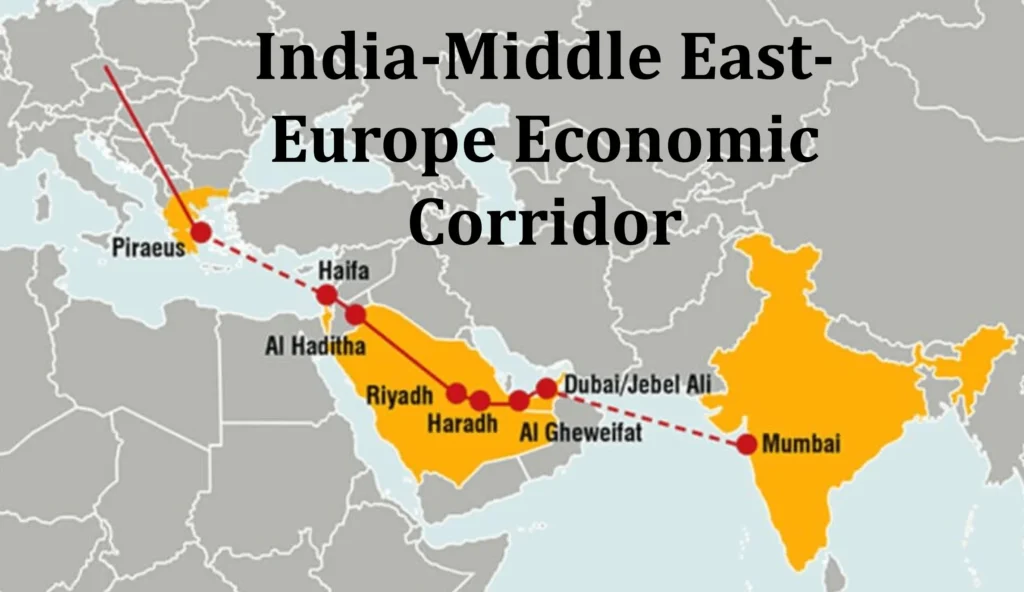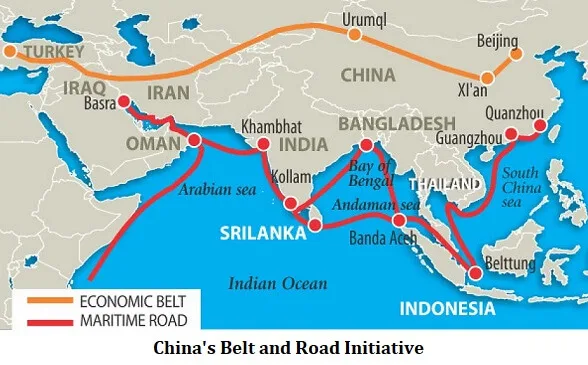
During a big meeting of world leaders at G20 in New Delhi, many aspects of diplomatic relations were discussed. These discussions were based on the mutual development of each member nation. Diplomatic Relations is a dynamic landscape which changes every now and then. In this dynamic landscape such regions becomes the hotbed of creativity and progress with ambitious projects revolving around it. One such remarkable project in news is a corridor named as IMEC Corridor. Designed to connect Europe and Asia this corridor encompasses several countries and institutions.
If this enormous project of linking two continents becomes successful it will impact the global infrastructure along with economic integration. This Corridor, its importance and the outstanding decisions being taken inside its bounds will all be covered in further detail in this blog post.
IMEC: India-Middle East-Europe Economic Corridor
IMEC stands for the India-Middle East-Europe Economic Corridor. As mentioned in my previous blog post on outcomes of G20, the entire corridor is divided into northern and Eastern corridor. With the aim to spread a network of connection and transportation makes it a massive infrastructural project. The connection that stretches from India via the Middle East to Europe. It comprises of all the three major routes of transportation i.e., the rail, road and sea route. Through it, trade and economic integration between Asia, the Arabian Gulf, and Europe are intended to increase.
Along with infrastructural development this project is also focusing on the green technologies such as hydrogen pipelines. It also keeps the idea of including super-fast internet connections and electrical systems within its domain. All these nations have decided to work within the framework of sustainable development and keeping up with modern advancements. According to majority of the population this project is crucial for these countries. It will open the door of progress and stability.
Counter to China’s BRI
One cannot discuss the it without comparing it to China’s Belt and Road Initiative (BRI). Both BRI and the newly declared IMEC projects share similar objectives of connecting different civilization and economies of varying capacity together. They also intend to boost the economies of the countries that are linked to these project. Although they may have common objectives but the path, they follow to reach it is different.

The BRI, initiated by China in 2013, is characterized by its opacity and reliance on funding primarily from China itself. The IMEC, on the other hand, is concerned with viability and is supported financially by a variety of sources, primarily through public-private partnerships. Due to the fundamentally different funding methods, the IMEC has a wider spectrum of stakeholders and more openness.
Moreover, the IMEC is not just about transportation infrastructure. As mentioned earlier, this project is highly ambitious to include underwater digital cables, renewable hydrogen transportation and data transfer and telecommunications. It is more than just a communication corridor. As more than 70% of the project’s infrastructure is already in place; rather, it is a geopolitical game-changer with wider regional consequences.
Economic benefits of the corridor
The India-Middle East-Europe Economic Corridor (IMEC) as the name suggest that it binds together many big and small economies together. It has several economic benefits under its belt. they are as follows:
Enhanced Trade
IMEC aims to create efficient transportation and connectivity networks. As a result, trade restrictions will be reduced, facilitating and lowering the cost of products interchange between the nations along the corridor. The economies of the member countries may expand as a result of increased commerce.
Economic Integration
IMEC promotes economic integration by linking various markets on its route. Thus, it may result in increased productivity and competitiveness when larger economic zones are created.
Diversification of Trade Routes
By providing alternative trade routes, IMEC reduces dependency on existing routes, such as those passing through the Suez Canal or the Strait of Hormuz. These type of diversification acts as a protective shield against disruptions and further it reduces transportation cost.
Job Creation
The construction and operation of IMEC infrastructure, including roads, railways, and ports, will generate employment opportunities. The local economies will undoubtedly benefit from this, and local governments will be able to cut unemployment as a result.
Supply Chain Resilience
IMEC offers an alternative to existing supply chains that may pass through politically unstable regions. This adaptability can guarantee a steady flow of commodities while defending against interruptions.
Investment Attraction
The development of IMEC is likely to attract foreign investments, both public and private, in the infrastructure and associated industries.
Technological Advancements
The modern technologies like hydrogen pipes and super-fast internet services will be among the other businesses that will be benefitted from this corridor apart from the transportation industry and moving cargoes.
Energy Efficiency
Industry sectors dependent on transportation and infrastructure can benefit from energy security and cost reductions as a result of IMEC’s focus on clean and efficient energy sources like hydrogen.
Global Trade Impact
IMEC’s strategic location between Asia, the Middle East, and Europe can facilitate global trade. These nations which are on the direct route of this corridor will experience a speedy trade and business development. Therefore, it is likely to change the world dynamics.
Competitive Advantage
Countries within the IMEC corridor, especially India, may gain a competitive advantage by offering faster and more efficient trade routes. This may draw companies and investment, so enhancing their economies.
Strategic Importance of IMEC
The India-Middle East-Europe Economic Corridor (IMEC) has several strategic significances:
Geopolitical Influence
IMEC’s development could increase the geopolitical influence of the countries within the corridor. The location of these countries will make them a strategic location thereby improving their global political positions.
Reduced Dependency
IMEC offers alternative trade routes that reduce dependency on critical chokepoints such as the Suez Canal and the Strait of Hormuz. This diversity will reduce their vulnerability towards disruptions in economy and will strengthen their boundaries thus reducing their dependency.
Strengthened Alliances
The corridor especially intends to lower the obstacles by enhancing connection between these countries. Because countries with similar economic interests frequently work together more closely in other sectors, this can result in stronger diplomatic and security ties.
Energy Security
IMEC’s attention to energy infrastructure, like hydrogen pipelines and electricity connections, can make sure these countries have a stable energy supply. This means they won’t be so easily affected by problems with their energy sources.
Enhanced Connectivity
IMEC can improve connectivity between regions, fostering better communication and cooperation in times of crisis or emergencies.
Trade Access
IMEC provides land-based trade access to countries that are traditionally reliant on sea routes. This can be strategically advantageous during times of conflict or political tensions.
Competing with BRI
IMEC can be seen as a counterbalance to China’s Belt and Road Initiative (BRI). It is an alternative to the China BRI which is also termed as a debt trap by the countries who are a part of it. IMEC will reduce the dominance of a single plan of development.
Regional Stability
Economic development and integration through IMEC can contribute to regional stability. As countries prosper, they are often less likely to engage in conflicts.
Reduced Transit Risk
IMEC will be able to reduce the risk involved in the transit by avoiding the potential instability in the transportation of the goods.
Global Trade Dynamics
IMEC’s strategic location between Asia, the Middle East, and Europe can have a ripple effect on global trade dynamics.
Conclusion
IMEC being a huge project has enough potential to change the global world order. There may be comparison between the IMEC and China led BRI but at the end they are not the same. IMEC is better at telling where it gets its money and does more things all around the world. As IMEC keeps going, it will be interesting to see how it affects the regions it touches and the whole world. It could make trade and connections better and also deal with some of the issues people have with the BRI. It is just a beginning because in the upcoming years we’ll see the success of the teamwork and the outcomes of the two parallel programs. I’ll keep you updated with the changing global scenarios by my future blogs.
